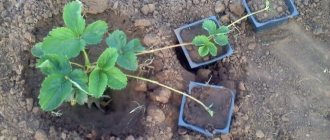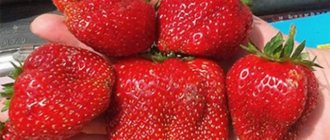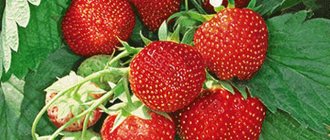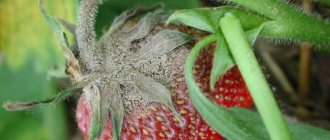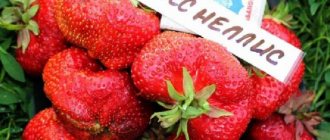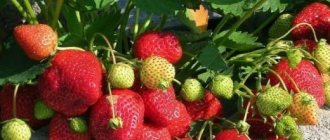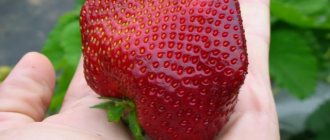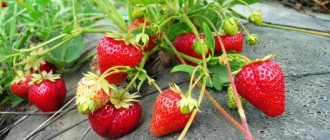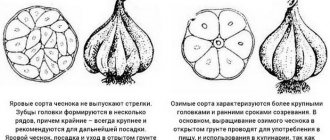Strawberries are called the queen of berries for a reason. Everyone loves tasty, aromatic berries, not only children, but also adults. And she is one of the first to ripen, in late May-early June. And if the varieties on the site are selected correctly, then you can enjoy strawberries all summer long. And by properly caring for the “queen”, you can double the strawberry yield. Experienced agronomist-gardener Manakov A.M. talks about what needs to be done.
In his opinion, strawberries are not a very picky crop. And is capable of producing abundant harvests. Of course, if high-quality planting material is grown, the plantings are located in a suitable location. And of course, if the planting deadlines are met. But you need to know some secrets of agricultural technology that will help significantly increase strawberry yields.
About varieties
Let's start by talking about varieties. We will not describe specific examples, but will give brief recommendations for choosing:
| Condition | Description |
| Zoning | The conditions for growing berries are different and strongly depend on the specific region: strawberries for the Moscow region differ from their Siberian relatives in many characteristics. Each region has its own productive varieties. |
| Ripening time | It is advisable to have several varieties on the site with different ripening periods: from early ripening in July to late in September. This extended the fruiting period, allowing you to get a second harvest of strawberries, and sometimes a third. |
| Climatic parameters | There is no change from year to year, rainy seasons often alternate with dry ones, and each of them will “shoot” |
Note: Growing remontant strawberries in addition to the usual varieties will diversify the diet of berries and extend the harvest time.
Strawberry yield
The best harvest is produced by remontant large-fruited varieties with high resistance to frost and pathogenic microflora. It is preferable to choose zoned options. In a favorable environment, such strawberries are distinguished not only by high fruiting, but also by good quality berries. However, experts regard the concept of “yield” as a relative criterion. Indeed, in different regions, a bush of the same selection can produce very different yield indicators.
For example, a big difference in the productivity of strawberry cultivation is observed on the plantations of research institutes, industrial farms, nurseries and amateur gardeners. Therefore, agronomists compare the fruiting qualities of plants only under equal soil, climatic and agrotechnical conditions.
Did you know? At New Orleans restaurant Arnaud's, the star ingredient in its most expensive, multimillion-dollar exclusive dish is
strawberries. It features fresh berries, cream, mint and a 5 carat pink diamond ring.
From 1 hundred square meters
There is no clear guideline for strawberry productivity. According to experienced gardeners who provided proper care for their plantation, in a favorable season, about 30 berries can be harvested from 1 bush.
To calculate the yield from 1 m², 1 hectare or 1 hectare, you need to take into account:
- ratio of area and planting density;
- varietal characteristics;
- repairability;
- age of seedlings;
- length of daylight hours;
- soil composition;
- growing method.
For example, from bushes of early ripening varieties (Alba, Kama, Divnaya, Honey, Fler, Olvia, Zephyr, Darenki, Clery, Octave, Kent, Asia, Elsanta) in short daylight conditions, even with proper care, you can collect no more than 250–300 g, i.e. 3.5–4 kg per hundred square meters. If these crops are grown under film, their yield will automatically double.
The figures for large-fruited varieties of Dutch selection Vima Xima, Gigantella Maxi, Vima Tarda are slightly higher - 4.3 kg per hundred square meters. But we are talking about plants that have reached two years of age, since the productivity of first-year seedlings is very low (1.5–2 times less).
From 1 ha
Industrial cultivation of strawberries is very different from amateur cultivation. For example, if most owners of private farms carefully pluck off the first ovary on seedlings planted in the spring to strengthen the root system, this method has not taken root in production fields due to its labor intensity. Consequently, specimens not treated in this way will not be able to lay many fruit buds for the future harvest.
Important! In spring, it is recommended to fertilize strawberries and strawberries with nitrogen-containing substances. And during flowering and ovary formation, the plant needs potassium, magnesium, phosphorus and iron.
Therefore, large producers prefer unpretentious large-fruited varieties with special taste characteristics of the fruit. Taking into account the characteristics of remontant varieties, which can produce up to 6 waves of fruiting per season, their gross yield is much higher. Harvesting on such specimens begins in early summer and lasts until late autumn.
But for some varieties the average berry weight is 60 g, while for others it is 100 g. On average, in a temperate climate zone, the popular varieties Honey, Marmelada, Elsanta, Alba, Vima Xima, Zenga Zengana can produce a yield of up to 30–38 kg/ha . And in Clery this figure reaches 40 kg/ha.
Similar yield indicators are found in varieties of neutral photoperiodic type, which bear fruit continuously, regardless of the length of daylight hours. It has been noticed that the fruiting of strawberries in fields where modern technologies for increasing productivity are used is several times higher than in the country garden. With the greenhouse growing method they are even higher.
Mulching berry fields
Creating optimal growing conditions will help increase the strawberry harvest. One of the most important agricultural practices is mulching.
Moreover, it is necessary to highlight cultivation under permanent cover, for example, various types of agrofibre, and mulching with plant materials.
The first method is increasingly used not only in open ground, but also in greenhouses, where work is more difficult to carry out due to cramped conditions. By using planting under agrofibre, you save on several types of work:
- weeding;
- loosening;
- frequency of watering.
The only inconvenience is related to fertilizing; you have to water it with liquid fertilizer directly under the root.
At the end of the spring cold weather, the film is removed from the greenhouse arcs
Mulching with natural materials also retards the development of weeds, although not so radically. In addition, the mulch itself acts as a top dressing. Judge for yourself, the following can act as covering materials:
Is it possible to water strawberries with cold water?
- pine litter;
- fallen leaves in autumn;
- hay;
- straw cutting;
- seed husk;
- humus;
- sawdust;
- compost.
In addition to these advantages, mulched berries are always clean and do not become dirty due to rain and watering.
What determines strawberry yield?
Among the world suppliers of strawberries, the United States of America is the leader, where up to 48 tons of crops are harvested from each hectare. In Europe, Spain is close to this indicator (44 t/ha). The lowest productivity of strawberry plantations is observed in regions with unstable temperatures and cold climates - winter comes there much earlier, which is why about 30% of the ovaries do not have time to ripen.
Did you know? From a botanical point of view, strawberries are not a berry, but a multi-nut. The fact is that the true fruits of this plant are tiny yellowish nuts located on the surface of a huge red receptacle.
Agronomists believe that the main factors influencing yield indicators are:
- soil characteristics (pH, nutritional value, composition);
- climatic and weather conditions;
- selection characteristics (maintenance, early ripening, winter hardiness, abundant fruiting);
- planting density;
- method of cultivation (open, closed);
- age of seedlings (every 3-4 years it is necessary to update planting material due to the rapid decline in the gross yield of its one-time fruiting);
- variety potential (number of rosettes and peduncles);
- planting dates (for example, bushes planted in September will give a smaller harvest than those planted in August);
- level of agricultural technology (frequency and methods of watering, fertilizing, preventive treatments against pests and common diseases, soil hygiene, preparation for wintering);
- timely harvesting;
- assembler qualification (relevant for industrial scale production).
Watering
“You can’t go there or go there without water,” said the famous song. No plant can survive without sufficient moisture.
However, when growing strawberries, many gardeners pay insufficient attention to this issue, sometimes relying only on natural precipitation. Meanwhile, competent and timely watering can increase the yield of berries quite significantly.
Strawberries should be watered during the entire growing season; in each case, watering has its own task.
| Deadlines | For what | How to water | Frequency |
| Upon landing | For seedling survival | Into the landing hole | One time |
| in spring | To clean the berry garden debris, moisture accumulation | Sprinkling | Once a week |
| During flowering | Ensure the growth and development of the bush | Under the bush | Two times a week |
| During fruiting | Pouring berries | Under the bush | Once in two weeks |
| Before winter | Sealing moisture to restore plant vigor | Mixed method: sprinkling and under the bush | Once a week |
Strawberries should be watered during the entire growing season; in each case, watering has its own task.
Attention! The data on the timing in the table are given under the condition that the soil is protected, without natural precipitation. Adjust the frequency of watering depending on rainfall.
Top dressing
No matter how fertile the soil is on the site, it is depleted over time, and the plants need additional nutrition. Proper fertilizing can significantly improve the yield of strawberries.
The number of feedings is indicated in the following screenshot.
Despite the fact that the table shows chemical elements, it is not necessary to use mineral fertilizers for fertilizing. These substances are also present in natural supplements:
- vermicompost;
- herbal tincture;
- ash;
- yeast.
Note: You can fertilize strawberries with a complex of the listed substances. At the same time, keep in mind: if you make an herbal infusion under the lid, the nitrogen will remain, but if it is open, it will evaporate.
Mulch is the best way to retain moisture
There are a number of plants that can survive drought conditions, but most will not survive long if deprived of water for a long period of time. With climate change, weather conditions can change so dramatically that they threaten the very survival of many plants. Strawberries that grow in soil that is poor in organic matter and tend to dry out quickly are most at risk.
To give plants a fighting chance against these extremes, use mulch in two ways:
Mixing mulch
Mixing mulch into the soil will make it richer and thus help retain moisture. Peat moss, leaf mold and grass clippings generally work best. Composted mulch retains moisture and provides plenty of natural nutrients. Mixing in manure will benefit both your plants and increase the level of microorganisms present in the soil.
Adding Mulch
Adding mulch to the soil will block the sun's rays and retain moisture in the soil. Young shrubs may have a much better chance of survival if you add a good layer of mulch to the soil around the trunk. Bark or sawdust is best.
Trimming
You need to trim strawberry bushes several times. First, the flower stalks that appear in the first year of the new plant’s life are removed.
This operation, on the one hand, deprives us of the opportunity to taste the very first berries, on the other hand, it allows the bush to save energy to build up leaf and root mass.
You should definitely trim your mustache during the period of mass fruiting of strawberries. Each tendril takes strength from the plant, the berries become smaller and decrease in quantity.
Be sure to trim your mustache during the period of mass fruiting of strawberries
Attention! If you want to grow tendrils for propagating berries, set aside a special area of the strawberry plantation with the strongest plants for this.
After the growing season, winter pruning is carried out, when not only the tendrils are removed, but sometimes all the leaves, leaving only the root rosette.
How to increase strawberry yields in open ground
Many land owners grow strawberries in a greenhouse or under cover, since this method is characterized by high fruiting and quality of the product. Bushes growing in open ground can also be stimulated. To do this, experts advise giving preference to high-yielding varieties and strictly observing agrotechnical requirements in caring for the berry garden.
Did you know? Residents of the Italian town of Nemi annually organize a strawberry festival, the main treat of which is ripe berries drenched in champagne, and they prepare the delicacy in a vat with a capacity of several thousand kilograms.
Selection of high-yielding varieties
Strawberry selection once again confirms the relativity of the concept of “yield”. After all, some varieties, even with unfavorable growth factors, produce abundant fruiting, while others under the same conditions are characterized by worse performance. For example, due to the many flower stalks, the Elsanta variety bush resembles a lush bouquet, while Clery and Marmalade have it much smaller. Elite large-fruited varieties with high winter-hardiness and immune qualities of the remontant type are profitable.
Popular today:
- Asia is an early ripening, winter-hardy variety of Italian selection. It is characterized by powerful high rosettes with an abundant number of peduncles, large foliage and a small number of tendrils. The berries weigh no more than 30 g, the first harvest ripens in the second decade of May. From one bush you can remove up to 1.2 kg of fruit.
- Honey is an early ripening creation of American breeders.
It is an unpretentious, erect, spreading bush, the fruits of which weigh on average about 35 g. The advantages of the variety can be considered its adaptability to short daylight hours, the taste and commercial qualities of the berries. The disadvantage is that at the end of fruiting the berries become smaller. You can harvest up to 1.5 kg of crop from one bush. Important! It is better to plant strawberries after root vegetables, legumes, onions, garlic and leafy vegetables. Nightshade crops are considered bad predecessors. - Chamora Turusi is a mid-season strawberry. It is distinguished by large juicy aromatic fruits, the average weight of which reaches 100–110 g. The bushes are tall, with wide foliage and an abundant amount of tendrils. Maximum fruiting occurs in the 2nd and 3rd years. The yield of one bush is about 1.5 kg. The disadvantage of this variety is its high sensitivity to fungal infections and pests.
- Queen Elizabeth is a remontant variety, the berries of which weigh on average about 60–70 g. Fruiting begins in the second ten days of May and lasts until the first frost. The interval between waves of fruit ripening (there are about 4 of them) does not exceed 14 days. If the weather is favorable, up to 2.2 kg of crop can be harvested from one bush. The plant is distinguished by its winter-hardy qualities and strong immunity. It is recommended to replant the planting every 2 years, since old bushes bear fruit poorly and the berries become very small.
- Temptation is considered the most productive variety from the remontant class. Its fruits weigh about 40 g and are characterized by a sweet taste with notes of nutmeg. Taste qualities are revealed more strongly closer to autumn. The disadvantage of this variety is the excessive growth of the mustache, which requires regular trimming. About 20 flower stalks are formed on the bush. The yield of one plant reaches 3 kg.
Correct care technology
Intense fruiting of strawberries is a merit not only of breeders, but also of the gardener, because the quantity and quality of berries depend on the potential of the seedlings, the organization of their planting and further care. What planting material to choose, where, how and when to plant it - all this was discussed above.
Important! After the first fruiting, it is necessary to feed the bushes with ammonia fertilizers or urea. The procedure is contraindicated only in remontant varieties.
You will learn further agrotechnical subtleties and secrets of experienced gardeners:
- The plantation with day-neutral plants should be renewed annually (keep in mind that specimens of the long photoperiodic type do not reduce yield for 36 months);
- strictly monitor the pH level in the soil (if it oxidizes, you will need to add fluff of lime, dolomite flour, cement dust or old plaster to the site at the rate of 150–300 g/m²);
- it is advisable to establish irrigation using drip systems , since sprinkling is contraindicated for strawberry rosettes (to avoid the formation of deep tunnels, young seedlings are not watered at the root);
- Timely preventive treatments of the plantation against pests (insecticides “Aktara”, “Aktellik” are used) and diseases (carried out with fungicides “Skor”, “Almaz 100”, “Horus”, “Camelot” are important);
- It is strictly forbidden to add soil or mulch to the bushes - excessive cover threatens oxygen deficiency and the death of the plant;
- also, from the second ten days of August, feeding rosettes is contraindicated (special attention is required to nitrogen-containing substances that cannot be applied until spring);
- after harvesting the first crop, be sure to loosen the soil (this manipulation is required even for beds covered with film, agrofibre or mulch);
- when feeding, avoid chlorine , it can destroy the plantation;
- To alkalize the soil, add dolomite flour only in the fall (if used in the spring, the growth of rosettes will be significantly slowed down);
- pick ripe berries in a timely manner , do not allow them to overripe (you need to tear them off along with the flower stalks), the same applies to the mustache (in excess they take away useful substances from the bush);
- if diseased rosettes are found, remove them along with the top layer of soil (up to 3 cm thick);
- during the rainy season, be sure to cover the plantation with a transparent plastic film and stop watering completely (this will protect the berries from excessive wateriness and improve their taste).
Pest Control
Pest protection cannot be neglected. Here are some tips to help you protect your favorite berries and ensure greater yield per square meter.
- In spring, spray the plantation with any biostimulant.
- If there is a high density of pests, a temporary shelter made of non-woven material will help to grow a rich harvest of berries.
- Plant phytoncidal plants that repel insects in neighboring beds.
- Fresh sawdust sprinkled between the rows will help fight snails. They prick the tender bellies of the mollusks, preventing them from entering the plantation.
Sawdust can be replaced with small shavings from a sawmill or woodworking machine
